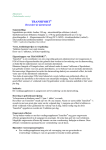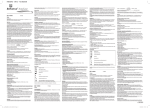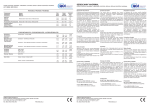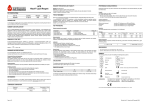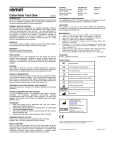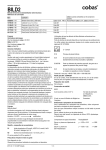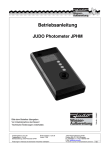Download Reflotron Pancreatic Amylase
Transcript
Assay For optimum performance of the assay follow the directions given in this document. Refer to the appropriate operator’s manual for instrument‑specific instructions. Reflotron Pancreatic Amylase 11126679 15 Reflotron English Intended use In vitro test for the quantitative determination of the specific activity of pancreatic α‑amylase (EC 3.2.1.1) in blood, serum, plasma or urine with Reflotron systems. Summary The α‑amylase (1,4‑α,D‑glycanohydrolase, EC 3.2.1.1) catalyzes the hydrolytic breakdown of polymeric carbohydrates like amylose, amylopectin and glycogen by cleavage of 1,4‑α‑glucosidic bonds. In polyand oligosaccharides, several glucosidic bonds are simultaneously hydrolyzed. Being the smallest unit, maltotriose is cleaved into maltose and glucose, at a much slower rate. Two types of α‑amylase are distinguished: the pancreatic type (P‑type) and the salivary gland type (S‑type). The P‑type comes almost exclusively from the pancreas, and is thus organ-specific; the S‑type can have various sources. On account of the rather non-specific clinical symptoms of pancreatic disease, enzyme determinations are of particular value in the diagnosis of these disorders. The determination of pancreatic α-amylase rather than total α-amylase is therefore of advantage here. The determination of pancreatic α‑amylase is suitable for the diagnosis and monitoring of acute pancreatitis and acute attacks of chronic pancreatitis. Pancreatic α‑amylase is of comparable clinical sensitivity and specificity to lipase as established pancreas-specific enzyme. Test principle After application to the test strip, the sample flows into the reaction zone, where, in the case of blood samples, the separation of the erythrocytes from the plasma occurs. The salivary gland α‑amylase is inhibited by 2 monoclonal antibodies. The pancreatic α‑amylase cleaves the substrate indolyl‑α,D‑maltoheptaoside; the α‑glucosidase contained in the test leads to the production of indoxyl and glucose. The released indoxyl is coupled with 2-methoxy-4-morpholinophenyldiazoniumtetrachlorozinkate to give a purple dye. The amount of dye formed per unit of time is directly proportional to the α‑amylase activity:1 pancreatic αamylase indolyl-α,D-maltoheptaoside indoxyl + glucose α-glucosidase indoxyl + 2-methoxy-4-morpholinophenyldiazoniumtetrachlorozincate purple dye The enzyme activity is measured kinetically at a wavelength of 567 nm and 37 °C, and is displayed after about 175 seconds in U/L or μkat/L. Reagents Components per test: Indolyl‑α,D‑maltoheptaoside 81 μg; α‑glucosidase (yeast rec.) ≥ 3.1 U; 2-methoxy-4-morpholinophenyldiazoniumtetrachlorozincate 6.8 μg; monoclonal antibodies 2.52 μg; buffer. Precautions and warnings For in vitro diagnostic use. Exercise the normal precautions required for handling all laboratory reagents. Disposal of all waste material should be in accordance with local guidelines. Safety data sheet available for professional user on request. Avoid any contact with the application zone of a test strip (e.g., during pipetting of sample). Reagent handling Test strips are ready‑for‑use. Storage and stability Store at 2–30 °C. Do not use the test strip after the specified expiration date. Specimen collection and preparation For specimen collection and preparation only use suitable tubes or collection containers. Capillary blood; whole blood collected in standard sample collection tubes; serum; heparinized blood, or heparinized plasma; urine. Use fresh capillary or venous blood immediately after collection. Use only heparin (preferably Li-heparin) as anticoagulant. Do not use any other anticoagulants or additives. Heparinized blood kept in closed containers must be used within 8 hours. After precipitation of the cellular components, the supernatant plasma can be used. If heparinized single-use containers or capillary pipettes are used, please observe the stability data given by the manufacturer. Serum and heparinized plasma collected in standard sample collection tubes is stable for 7 days at 4-25 °C, or for 1 month at 2-8 °C.2 Stability in urine: 10 days at 4–8 °C; 2 days at 20–25 °C Sample volume: 30 μL Materials provided 1 container with 15 test strips ▪ Remove a test strip from the container. Tightly recap the container immediately after removing a test strip. ▪ Peel off the aluminium protective foil, taking care not to bend the test strip. ▪ All Reflotron tests require a sample volume of 30 μL. ▪ Apply the required volume of sample onto the centre of the red application zone using a pipette (e.g., Reflotron pipette) – being careful not to touch the application zone. Avoid air‑bubbles. ▪ Open the flap or sliding cover. Within 15 seconds of applying the sample, place the test strip onto the guide, and slide it forward horizontally until it locks into place. Close the sliding cover or flap. ▪ The test parameter abbreviation is shown on the display, if the test strip has been correctly inserted and the magnetic code has been read. The result is displayed depending on the setting of the instrument. Calibration The function curve for the Reflotron Pancreatic Amylase assay for converting reflectance values into activities is defined for each lot using the pancreatic α‑amylase liquid method from Roche Diagnostics. The parameters of the curve are automatically transferred to the instrument via the magnetic strip during testing. Quality control For quality control, use Reflotron Precinorm U and Reflotron Precipath U. The control intervals and limits should be adapted to each laboratory’s individual requirements. Values obtained should fall within the defined limits. Each laboratory should establish corrective measures to be taken if values fall outside the defined limits. Follow the applicable government regulations and local guidelines for quality control. Calculation The pancreatic amylase activity is calculated automatically from the measurements taken, as well as function and conversion factors read from the magnetic strip on the lower face of each test strip. The enzyme activity is shown for 25 °C, 30 °C or 37 °C in U/L or μkat/L, depending on the way the instrument has been set. Limitations - interference The following had no influence on the results in the concentration ranges tested (criterion: recovery ± 10 % of baseline):3 haematocrit up to 55 %, haemoglobin up to 0.37 mmol/L (6 g/L), bilirubin up to 360 μmol/L (21 mg/dL), triglycerides up to 25.9 mmol/L (2272 mg/dL), cholesterol up to 14.8 mmol/L (572 mg/L), other endogenous substances and 26 further drugs. Saliva and sweat contain α‑amylase. Care must be taken to avoid touching the application zone, or test area. The residual activity of salivary gland amylase is approx. 7 %. In rare cases, very high activities of salivary gland α‑amylase can lead to elevated results for pancreatic α‑amylase. Toxic concentrations of paracetamol have been found to produce reduced pancreatic α-amylase activities. Ascorbic acid concentrations above 10 mg/dL lead to increased recovery. High maltose concentrations of > 300 mg/dL lead to falsely low test results. As a result, patients undergoing peritoneal dialysis cannot be tested with the Reflotron Amylase or Reflotron Pancreatic Amylase assays because of their high maltose levels. For diagnostic purposes, the results should always be assessed in conjunction with the patient’s medical history, clinical examination and other findings. Measuring range Blood, serum, plasma: 14–850 U/L or 0.23–14.17 μkat/L. If the pancreatic α‑amylase activity measured in serum or plasma is above the measuring range for the Reflotron Pancreatic Amylase assay (indicated by an asterisk next to the displayed value or the message DILUTE P-AM) the sample may be diluted 1 + 3 with physiological saline solution. Multiply the result by a factor of 4. Urine: 57.1–2380 U/L or 0.95–39.66 μkat/L. Dilute the urine samples 1 + 3 with distilled water. Multiply the result by a factor of 4. Expected values Adults: Blood, serum, plasma:4 < 53 U/L or < 0.89 μkat/L (37 °C, 30 °C, 25 °C). Random urine:4 < 325 U/L or < 5.42 μkat/L (37 °C, 30 °C, 25 °C). For technical reasons the value is the same at 37 °C, 30 °C and 25 °C. Each laboratory should investigate the transferability of the expected values to its own patient population and if necessary determine its own reference ranges. Specific performance data The data for the Reflotron Pancreatic Amylase assay were determined in evaluation studies. The majority of the test results were within the given ranges. Bindungen gleichzeitig hydrolisiert. Als kleinste Einheit wird Maltotriose, allerdings mit wesentlich geringerer Geschwindigkeit, in Maltose und Glucose gespalten. Man unterscheidet zwei Typen von α‑Amylasen, den Pankreas-Typ (P‑Typ) und den Speicheldrüsen-Typ (S‑Typ). Während der P‑Typ praktisch ausschließlich dem Pankreas und damit organspezifisch zugeordnet werden kann, ist der S‑Typ unterschiedlicher Herkunft. Da Enzymbestimmungen aufgrund der wenig spezifischen klinischen Symptomatik von Pankreaserkrankungen vor allem in der Pankreas-Diagnostik einen hohen Stellenwert haben, ist hier die Bestimmung der Pankreas-α-Amylase anstelle der Gesamt-α-Amylase von Vorteil. Die Bestimmung der Pankreas-α‑Amylase eignet sich zur Diagnose und Verlaufskontrolle der akuten Pankreatitis und akuten Schüben der chronischen Pankreatitis. Die Pankreas-α‑Amylase ist in klinischer Sensitivität und Spezifität der Lipase als anerkannt Pankreas-spezifischem Enzym vergleichbar. Testprinzip Nach dem Auftragen auf den Teststreifen fließt die Probe, bei Blut unter Abtrennung der Erythrozyten, in die Reaktionszone. Die Hemmung der Speichel-α‑Amylase erfolgt mit 2 monoklonalen Antikörpern. Die Pankreas-α‑Amylase spaltet das Substrat Indolyl‑α,D‑maltoheptaosid; durch das im Test enthaltene Enzym α‑Glucosidase entstehen Indoxyl und Glucose. Das freiwerdende Indoxyl wird mit 2-Methoxy-4-morpholinophenyldiazonium-tetrachlorozinkat zu einem rotvioletten Farbstoff gekuppelt. Die Menge des gebildeten Farbstoffs pro Zeiteinheit ist direkt proportional zur Aktivität der α‑Amylase:1 Pancreas-αAmylase Indolyl-α,D-maltoheptaosid Indoxyl + Glucose α-Glucosidase Indoxyl + 2-Methoxy-4-morpholinophenyldiazonium-tetrachlorozinkat rotvioletter Farbstoff Die Enzymaktivität wird bei einer Wellenlänge von 567 nm und 37 °C kinetisch gemessen. Das Ergebnis wird nach ca. 175 Sekunden in U/L oder µkat/L angezeigt. Reagenzien Inhaltsstoffe pro Testfeld: Indolyl‑α,D‑maltoheptaosid 81 μg; α‑Glucosidase (Hefe rek.) ≥ 3.1 U; 2-Methoxy-4-morpholinophenyldiazonium-tetrachlorozinkat 6.8 μg; monoklonale Antikörper 2.52 μg; Puffer. Vorsichtsmaßnahmen und Warnhinweise In-vitro-Diagnostikum. Die beim Umgang mit Laborreagenzien üblichen Vorsichtsmaßnahmen beachten. Die Entsorgung aller Abfälle ist gemäß den lokalen Richtlinien durchzuführen. Sicherheitsdatenblatt auf Anfrage für berufsmäßige Benutzer erhältlich. Auftragezone eines Reagenzträgers (z.B. beim Auftragen einer Probe) nicht berühren. Reagenz-Handhabung Die Teststreifen sind gebrauchsfertig. Lagerung und Haltbarkeit Aufbewahrung bei 2-30 °C Teststreifen nicht über das angegebene Verfallsdatum hinaus verwenden. Probenentnahme und Vorbereitung Zur Probenentnahme und -vorbereitung nur geeignete Röhrchen oder Sammelgefäße verwenden. Kapillarblut; mit Standard-Probenentnahmeröhrchen entnommenes Vollblut; Serum; Heparinblut oder Heparinplasma; Urin. Frisches Kapillar- oder Venenblut sofort nach der Entnahme einsetzen. Als Antikoagulanz nur Heparin (vorzugsweise Lithiumheparin) verwenden. Keine anderen Antikoagulanzien oder Zusatzstoffe verwenden. In geschlossenen Gefäßen aufbewahrtes Heparinblut innerhalb von 8 Stunden verwenden. Nach dem Absetzen der zellulären Bestandteile kann das überstehende Plasma verwendet werden. Bei Verwendung von heparinisierten Einmalgefäßen oder Kapillarpipetten sind die Haltbarkeitsdaten des Herstellers zu beachten. Bei Serum und Heparinplasma, entnommen mit Standard-Probenentnahmeröhrchen, beträgt die Haltbarkeit 7 Tage bei 4-25 °C oder 1 Monat bei 2-8 °C.2 Haltbarkeit in Urin: 10 Tage bei 4-8° C; 2 Tage bei 20-25° C Probenvolumen: 30 μL Gelieferte Materialien 1 Röhre mit 15 Teststreifen Precision Repeatability (within-run precision): CV (coefficient of variation) 2.6 % in the low range, 2.3 % in the pathological range; sample material: heparinized blood. Intermediate precision (between-day precision): CV 4.0 % in the normal range, 4.5 % in the pathological range; sample material: control sera. Zusätzlich benötigte Materialien Method comparison A comparison of the Reflotron Pancreatic Amylase assay (y) with the pancreatic α‑amylase PNP assay (x) using either serum, heparinized blood or heparinized plasma gave the following correlations: y = 0.97x – 3.3; n = 50; r = 0.996 For further information, please refer to the appropriate operator’s manual for the analyzer concerned, and the Method Sheets of all necessary components. A point (period/stop) is always used in this Method Sheet as the decimal separator to mark the border between the integral and the fractional parts of a decimal numeral. Separators for thousands are not used. Significant additions or changes are indicated by a change bar in the margin. ▪ 0.9 % NaCl Allgemein übliche Laborausrüstung ▪ Reflotron Gerät Reflotron Pipette Reflotron Pipettenspitzen Reflotron Kapillarröhrchen ▪ Reflotron Precinorm U und Reflotron Precipath U Testdurchführung Um eine einwandfreie Funktion des Tests sicherzustellen, sind die Anweisungen in diesem Dokument zu befolgen. Gerätespezifische Testanweisungen sind im entsprechenden Bedienungshandbuch zu finden. ▪ Einen Teststreifen aus der Röhre entnehmen. Röhre nach Entnahme eines Teststreifens sofort wieder fest verschließen. ▪ Schutzfolie vom Teststreifen entfernen, hierbei den Teststreifen nicht durchbiegen. Materials required (but not provided) ▪ Bei allen Reflotron Tests ist ein Probenvolumen von 30 µL erforderlich. ▪ Reflotron instrument Reflotron pipette Reflotron pipette tips Reflotron capillary tubes ▪ Benötigtes Probenvolumen mit einer Pipette (z.B. Reflotron Pipette) aufnehmen und zentral auf den roten Teil der Auftragezone applizieren, ohne diese mit der Pipettenspitze zu berühren. Luftblasen vermeiden. ▪ ▪ Reflotron Precinorm U and Reflotron Precipath U Klappe bzw. Schieber öffnen. Reagenzträger innerhalb von 15 Sekunden nach dem Auftragen der Probe in die Führungsschiene stecken und waagrecht bis zum spürbaren Einrasten einschieben. Schieber bzw. Klappe schließen. ▪ Im Display erscheint die Abkürzung des Testparameters, wenn der Teststreifen korrekt eingelegt und der Magnetcode eingelesen wurde. Das Ergebnis wird je nach Einstellung des Gerätes angezeigt. ▪ 0.9 % NaCl General laboratory equipment Deutsch Anwendungszweck In-vitro-Test zur quantitativen Bestimmung der spezifischen Aktivität der Pankreas-α‑Amylase (EC 3.2.1.1) in Blut, Serum, Plasma oder Urin mit Reflotron Systemen. Zusammenfassung Die α‑Amylase (1,4‑α,D‑Glycanohydrolase, EC 3.2.1.1) katalysiert den hydrolytischen Abbau von polymeren Kohlenhydraten wie Amylose, Amylopektin und Glykogen durch Spaltung von 1,4‑α‑glucosidischen Bindungen. Bei Poly- und Oligosacchariden werden immer mehrere glucosidische Kalibration Die Festlegung der Funktionskurve von Reflotron Pancreatic Amylase zur Umrechnung von Reflexionswerten in Aktivitäten erfolgt chargenspezifisch unter Verwendung der Pankreas-α‑Amylase liquid Methode von Roche Diagnostics. Die Daten werden über das Magnetband automatisch an das Gerät übermittelt. Qualitätskontrolle Zur Qualitätskontrolle Reflotron Precinorm U und Reflotron Precipath U verwenden. Die Kontrollintervalle und Kontrollgrenzen sind den individuellen Anforderungen jedes Labors anzupassen. Die Ergebnisse müssen innerhalb der definierten Bereiche liegen. Jedes Labor sollte Korrekturmaßnahmen für den Fall festlegen, dass Werte außerhalb der festgelegten Grenzen liegen. Bei der Qualitätskontrolle die entsprechenden Gesetzesvorgaben und Richtlinien beachten. Berechnung Die gemessene Pankreasamylase-Aktivität wird mit Hilfe einer Funktion und Umrechnungsfaktoren, die dem Gerät durch das Magnetband auf der Reagenzträgerunterseite übermittelt werden, ausgewertet und automatisch berechnet. Je nach Einstellung des Gerätes wird die Enzymaktivität für 25°C, 30°C oder 37°C in U/L bzw. μkat/L angezeigt. Einschränkungen des Verfahrens - Interferenzen Eine Beeinflussung der Testergebnisse durch folgende Substanzen in den geprüften Konzentrationsbereichen wurde nicht festgestellt (als Bewertung gilt: Wiederfindung ± 10 % vom Ausgangswert):3 Hämatokritwerte bis 55 %, Hämoglobin bis 0.37 mmol/L (6 g/L), Bilirubin bis 360 μmol/L (21 mg/dL), Triglyceride bis 25.9 mmol/L (2272 mg/dL), Cholesterin bis 14.8 mmol/L (572 mg/dL), andere endogene Substanzen sowie 26 weitere geprüfte Arzneiwirkstoffe. Speichel und Schweiß enthalten α‑Amylase. Auftragezone und Testfeld nicht berühren. Die Restaktivität der Speichelamylase beträgt ca. 7 %. In seltenen Fällen können sehr hohe Aktivitäten der Speichelα‑Amylase zu erhöhten Messwerten für die Pankreas-α‑Amylase führen. Bei toxischen Paracetamolkonzentrationen wurden erniedrigte Pankreas-α-Amylase-Aktivitäten festgestellt. Ascorbinsäurekonzentrationen über 10 mg/dL führen zu einer erhöhten Wiederfindung. Hohe Maltosekonzentrationen von > 300 mg/dL führen zu falsch niedrigen Testergebnissen. Da Peritonealdialysepatienten hohe Maltosekonzentrationen aufweisen, können die Reflotron Amylase oder Reflotron Pancreatic Amylase Tests bei ihnen nicht durchgeführt werden. Für diagnostische Zwecke sind die Ergebnisse stets im Zusammenhang mit der Patientenvorgeschichte, der klinischen Untersuchung und anderen Untersuchungsergebnissen zu werten. Messbereich Blut, Serum, Plasma: 14-850 U/L bzw. 0.23-14.17 µkat/L Liegt die in Serum oder Plasma gemessene Pankreas-α‑Amylase-Aktivität oberhalb des Messbereiches für den Reflotron Pancreatic Amylase Test (im Display erscheint zusätzlich * oder VERDUENNEN P-AM), so kann die Probe mit physiologischer Kochsalzlösung im Verhältnis 1 + 3 verdünnt werden. Das Ergebnis mit dem Faktor 4 multiplizieren. Urin: 57.1-2380 U/L bzw. 0.95-39.66 µkat/L Urinproben 1 + 3 mit destilliertem Wasser verdünnen. Das Ergebnis mit dem Faktor 4 multiplizieren. Referenzwerte Erwachsene: Blut, Serum, Plasma:4 < 53 U/L bzw. < 0.89 μkat/L (37 °C, 30 °C, 25 °C) Spontanurin:4 < 325 U/L bzw. < 5.42 μkat/L (37 °C, 30 °C, 25 °C) Aus technischen Gründe sind die Werte bei 37 °C, 30 °C und 25 °C identisch. Jedes Labor sollte die Übertragbarkeit der Referenzbereiche für die eigenen Patientengruppen überprüfen und gegebenenfalls selbst ermitteln. Spezifische Leistungsdaten des Tests Die Daten für den Reflotron Pancreatic Amylase Test wurden in Erprobungsuntersuchungen ermittelt. Die Mehrheit der Testergebnisse lag innerhalb der angegebenen Bereiche. Präzision Wiederholpräzision (Präzision in der Serie): VK (Variationskoeffizient) im niedrigen Bereich 2.6 %, im pathologischen Bereich 2.3 %; Probenmaterial: Heparinblut. Zwischenpräzision (Tag/Tag-Präzision): VK im Normalbereich 4.0 %, im pathologischen Bereich 4.5 %; Probenmaterial: Kontrollseren. Methodenvergleich Ein Vergleich des Reflotron Pancreatic Amylase Tests (y) mit dem Pancreatic α‑Amylase PNP Test (x) in Serum, Heparinblut oder Heparinplasma ergab folgende Korrelationen: y = 0.97x – 3.3; n = 50; r = 0.996 Weitergehende Informationen siehe Bedienungshandbuch des jeweiligen Gerätes sowie die Methodenblätter aller erforderlichen Komponenten. Um die Grenze zwischen dem ganzzahligen Teil und dem gebrochenen Teil einer Zahl anzugeben, wird in diesem Methodenblatt immer ein Punkt als Dezimaltrennzeichen verwendet. Tausendertrennzeichen werden nicht verwendet. Signifikante Ergänzungen oder Änderungen sind durch eine Markierung am Rand gekennzeichnet. Français Domaine d'utilisation Test in vitro pour la détermination quantitative de l'activité spécifique de l'α‑amylase pancréatique (EC 3.2.1.1) dans le sang, le sérum, le plasma ou l'urine sur les systèmes Reflotron. Caractéristiques L'α‑amylase (1,4‑α,D‑glucanohydrolase, EC 3.2.1.1) catalyse l'hydrolyse des liaisons 1,4‑α‑glucosidiques de glucides polymères comme l'amylose, l'amylopectine et le glycogène. Plusieurs liaisons glucosidiques sont toujours hydrolysées simultanément dans les oligosaccharides et les polysaccharides. Le maltotriose est la plus petite unité; son hydrolyse, très lente, conduit à la formation de maltose et de glucose. On distingue deux types d’α‑amylases, le type pancréatique (type P) et le type salivaire (type S). Alors que le type P est presque exclusivement d’origine pancréatique et, de ce fait, spécifique d’organe, le type S a des origines diverses. Du fait du manque de spécificité des symptômes cliniques, les dosages enzymatiques revêtent une grande importance dans le diagnostic des affections pancréatiques. Il est là utile de pouvoir déterminer l’activité de l'α‑amylase pancréatique plutôt que celle de l'α‑amylase totale. Le dosage de l’α‑amylase pancréatique est utilisé pour le diagnostic et le suivi des pancréatites aiguës ainsi que des poussées aiguës des pancréatites chroniques. La sensibilité et la spécificité clinique de l’α‑amylase pancréatique sont comparables à celles de la lipase, enzyme admise comme étant spécifique du pancréas. Principe Une fois déposé sur la bandelette-test, l'échantillon s'infiltre dans la zone réactive, où, en cas d'échantillon de sang, les érythrocytes sont séparés du plasma. L’α‑amylase salivaire est inhibée par 2 anticorps monoclonaux. Le substrat indolyl‑α,D‑maltoheptaose est scindé par l'α‑amylase pancréatique non inhibée présente dans l’échantillon; l’action de l’α‑glucosidase contenue dans le test conduit à la formation d‘indoxyle et de glucose. L'indoxyle libéré est couplé avec le 05960355001 2014-08 V 2.0 tétrachlorozincate de méthoxy‑2 morpholinophényl‑4 benzènediazonium pour donner un dérivé coloré violet. La quantité de dérivé coloré formée par unité de temps est directement proportionnelle à l'activité de l'α‑amylase:1 α-amylase pancréatique indolyl-α,D-maltoheptaose indoxyle + glucose α-glucosidase indoxyle + méthoxy‑2 morpholinophényl‑4 benzènediazonium dérivé coloré violet La concentration en amylase est proportionnelle à l'activité enzymatique qui est mesurée par une méthode cinétique à 37 °C à une longueur d'onde de 567 nm. Le résultat est affiché en U/L ou en µkat/L après environ 175 secondes. Réactifs Composants par test: Indolyl‑α,D‑maltoheptaoside 81 μg; α‑glucosidase (levure, rec.) ≥ 3.1 U; tétrachlorozincate de méthoxy‑2 morpholinophényl‑4 benzènediazonium 6.8 μg; anticorps monoclonaux 2.52 μg; tampon. Précautions d’emploi et mises en garde Pour diagnostic in vitro. Observer les précautions habituelles de manipulation en laboratoire. L’élimination de tous les déchets doit être effectuée conformément aux dispositions légales. Fiche de données de sécurité disponible sur demande pour les professionnels. Éviter tout contact avec la zone de dépôt de la bandelette‑test (par ex. lors du pipetage de l'échantillon). Préparation des réactifs Les bandelettes-tests sont prêtes à l’emploi. Conservation et stabilité Conservation entre 2 et 30 °C. Ne pas utiliser la bandelette-test après la date de péremption. Prélèvement et préparation des échantillons Pour le prélèvement et la préparation des échantillons, utiliser uniquement des tubes ou récipients de recueil appropriés. Sang capillaire; sang total recueilli sur tubes de prélèvement standard; sérum, sang hépariné ou plasma hépariné; urine. Utiliser du sang capillaire ou du sang veineux frais et effectuer l'analyse immédiatement après le prélèvement. Utiliser uniquement l'héparine comme anticoagulant (préférer l’héparinate de lithium). Ne pas utiliser d'autres anticoagulants ou additifs. Le sang hépariné doit être conservé dans des récipients bouchés et utilisé dans les 8 heures. Après sédimentation des éléments figurés, le surnageant peut être utilisé. En cas d'utilisation de tubes à usage unique ou de tubes capillaires héparinés, observer les données de stabilité indiquées par le fabricant. Le sérum et le plasma hépariné prélevés sur tubes standard sont stables 7 jours entre 4 et 25 °C ou 1 mois entre 2 et 8 °C.2 Stabilité dans l'urine: 10 jours entre 4 et 8 °C; 2 jours entre 20 et 25 °C Volume de l'échantillon: 30 μL Matériel fourni 1 tube de 15 bandelettes-tests Matériel auxiliaire nécessaire ▪ ▪ Analyseur Reflotron Reflotron pipettes Reflotron pipette tips Reflotron capillary tubes Reflotron Precinorm U et Reflotron Precipath U ▪ Solution de NaCl à 0.9 % Equipement habituel de laboratoire Se conformer à la réglementation gouvernementale et aux directives locales en vigueur relatives au contrôle de qualité. α‑amilasi pancreatica Calcul des résultats L'activité de l'amylase pancréatique est calculée automatiquement à partir du résultat de mesure ainsi que des facteurs de fonction et de conversion lus par la bande magnétique située au dos de chaque bandelette‑test. L'activité enzymatique est donnée pour des mesures à 25 °C, 30 °C ou 37 °C, en U/L ou en μkat/L, selon les réglages de l'appareil. indolil-α,D-maltoeptaoside Limites d’utilisation - interférences Les facteurs suivants n'ont pas eu d'influence sur les résultats aux concentrations testées (critère: recouvrement ± 10 % de la ligne de base):3 l'hématocrite jusqu'à 55 %, l'hémoglobine jusqu'à 0.37 mmol/L (6 g/L), la bilirubine jusqu'à 360 μmol/L (21 mg/dL), les triglycérides jusqu'à 25.9 mmol/L (2272 mg/dL), le cholestérol jusqu'à 14.8 mmol/L (572 mg/L), de même que d'autres substances endogènes et 26 médicaments. La salive et la sueur renferment de l’α‑amylase. Veiller à ne pas toucher les zones de dépôt et de mesure. L’activité résiduelle de l’amylase salivaire est d'environ 7 %. Dans de rares cas, une activité très élevée d'α‑amylase salivaire peut conduire à l'obtention de taux d'α‑amylase pancréatique faussement élevés. Aux concentrations toxiques, le paracétamol a conduit à des activités d’α‑amylase pancréatique diminués. Des concentrations en acide ascorbique supérieures à 10 mg/dL conduisent à des taux de récupération augmentés. De fortes concentrations en maltose > 300 mg/dL conduisent à l'obtention de résultats faussement bas. Par conséquent, les tests Reflotron Amylase ou Reflotron Pancreatic Amylase ne peuvent pas être utilisés chez les patients soumis à une dialyse péritonéale en raison de leurs taux de maltose élevés. Pour le diagnostic, les résultats doivent toujours être confrontés aux données de l’anamnèse du patient, au tableau clinique et aux résultats d’autres examens. indossile + 2‑metossi4‑morfolinofenildiazoniotetraclorozincato Domaine de mesure Sang, sérum, plasma: 14–850 U/L ou 0.23–14.17 µkat/L Si l'activité de l’α‑amylase pancréatique mesurée dans le sérum ou le plasma se situe au‑dessus de la limite supérieure de l'intervalle de mesure du test Reflotron Pancreatic Amylase (signalé par une astérisque apposée à la valeur affichée ou le message P‑AM DILUER), l'échantillon peut être dilué dans le rapport 1 + 3 à l'aide d'une solution physiologique de chlorure de sodium. Multiplier le résultat par 4. Urine: 57.1–2380 U/L ou 0.95–39.66 μkat/L. Diluer les échantillons d'urine dans le rapport 1 + 3 avec de l'eau distillée. Multiplier le résultat par 4. Valeurs de référence Adultes: Sang, sérum, plasma:4 < 53 U/L ou < 0.89 μkat/L (37 °C, 30 °C, 25 °C) Urine recueillie en cours de miction:4 < 325 U/L ou < 5.42 μkat/L (37 °C, 30 °C, 25 °C) Pour des raisons techniques, la valeur est la même à 37 °C, 30 °C et 25 °C. Chaque laboratoire devra vérifier la validité de ces valeurs et établir au besoin ses propres domaines de référence selon la population examinée. Performances analytiques Les données ci-dessous sont le résultat d’études d'évaluation réalisées sur le test Reflotron Pancreatic Amylase. La majorité des résultats du test se situait dans les intervalles de valeurs indiqués. Précision Répétabilité (précision intra-série): CV (coefficient de variation) 2.6 % dans l'intervalle des concentrations basses, 2.3 % dans l'intervalle pathologique; type d'échantillon: sang hépariné Précision intermédiaire (précision inter-jours): CV 4.0 % dans l'intervalle des concentrations normales, 4.5 % dans l'intervalle pathologique; type d'échantillon: sérum de contrôle Comparaison de méthodes Une comparaison du test Reflotron Pancreatic Amylase (y) avec le test pancreatic α‑amylase PNP (x) effectué sur du sérum, du sang hépariné ou du plasma hépariné a donné les corrélations suivantes: y = 0.97x – 3.3; n = 50; r = 0.996 Pour de plus amples informations, se référer au manuel d'utilisation de l'analyseur concerné et aux fiches techniques de tous les réactifs nécessaires. Dans cette fiche technique, le séparateur décimal pour partager la partie décimale de la partie entière d'un nombre décimal est un point. Aucun séparateur de milliers n'est utilisé. Les modifications importantes par rapport à la version précédente sont signalées par une barre verticale dans la marge. indossile + glucosio α‑glucosidasi colorante porpora L'attività enzimatica viene misurata cineticamente ad una lunghezza d'onda di 567 nm e ad una temperatura di 37 °C; dopo ca. 175 secondi il display visualizza il risultato in U/L oppure μkat/L. Reagenti Componenti per test: indolil‑α,D‑maltoeptaoside: 81 μg; α‑glucosidasi (lievito ric.): ≥3.1 U; 2‑metossi-4‑morfolinofenildiazoniotetraclorozincato: 6.8 μg; anticorpi monoclonali: 2.52 µg; tampone. Precauzioni e avvertenze Per uso diagnostico in vitro. Osservare le precauzioni normalmente adottate durante la manipolazione dei reagenti di laboratorio. Lo smaltimento di tutti i rifiuti deve avvenire secondo le direttive locali. Scheda dati di sicurezza disponibile su richiesta per gli utilizzatori professionali. Evitare sempre il contatto con la zona di reazione della striscia reattiva (ad es. durante il pipettamento del campione). Utilizzo dei reattivi Le strisce reattive sono pronte all’uso. Conservazione e stabilità Conservare a 2‑30 °C. Non usare la striscia reattiva oltre la data di scadenza indicata. Prelievo e preparazione dei campioni Per il prelievo e la preparazione dei campioni impiegare solo provette o contenitori di raccolta adatti. Sangue capillare; sangue intero prelevato in apposite provette standard; siero; sangue eparinato o plasma eparinato; urina. Impiegare il sangue capillare o venoso fresco immediatamente dopo il prelievo. Usare esclusivamente eparina (preferibilmente litio eparina) come anticoagulante. Non usare altri anticoagulanti o additivi. Il sangue eparinato conservato in recipienti chiusi deve essere utilizzato entro 8 ore. Dopo la precipitazione dei componenti cellulari è possibile utilizzare il plasma surnatante. Per l'impiego di provette usa e getta o pipette capillari eparinate, osservare le indicazioni relative alla stabilità riportate dal rispettivo produttore. Il siero ed il plasma eparinato prelevati in provette standard sono stabili 7 giorni a 4‑25 °C o 1 mese a 2‑8 °C.2 Stabilità nell'urina: 10 giorni a 4‑8 °C; 2 giorni a 20‑25 °C Volume del campione: 30 µL Materiali a disposizione 1 contenitore da 15 strisce reattive Materiali necessari (ma non forniti) ▪ ▪ Strumento Reflotron Pipetta Reflotron Puntali di pipettaggio Reflotron Tubi capillari Reflotron Reflotron Precinorm U e Reflotron Precipath U ▪ NaCl (0.9 %) Normale attrezzatura da laboratorio Esecuzione Per una performance ottimale del test, attenersi alle indicazioni riportate in questo documento. Per le istruzioni specifiche dello strumento, consultare il manuale d'uso appropriato. ▪ Prelevare una striscia reattiva dal contenitore. Richiudere il contenitore ermeticamente subito dopo aver tolto una striscia reattiva. ▪ Togliere la lamina di protezione in alluminio, evitando di piegare la striscia reattiva. ▪ Volume del campione necessario per tutti i test Reflotron: 30 µL. ▪ Applicare il volume del campione necessario al centro della zona reattiva rossa con una pipetta (ad es. pipetta Reflotron), assicurandosi di non toccare tale zona. Evitare la formazione di bolle d’aria. ▪ Aprire lo sportello dello strumento. Entro 15 secondi dall’applicazione del campione, inserire la striscia orizzontalmente lungo la guida fino al serraggio completo. Richiudere lo sportello. ▪ Sul display appare l'acronimo del parametro test‑specifico che conferma il corretto inserimento della striscia reattiva e l'avvenuta lettura del codice magnetico. Il risultato viene visualizzato a seconda delle impostazioni programmate nello strumento. Réalisation du test Pour obtenir les performances analytiques optimales, suivre attentivement les instructions données dans le présent document. Pour les instructions spécifiques de l’appareil, se référer au manuel d’utilisation approprié. Italiano Finalità d’uso Test in vitro per la determinazione quantitativa dell'attività specifica dell'α‑amilasi pancreatica (EC 3.2.1.1) in campioni di sangue, siero, plasma o urina, impiegando sistemi Reflotron. ▪ Sortir une bandelette‑test du tube. Toujours bien refermer le tube immédiatement après en avoir extrait une bandelette. ▪ Retirer la feuille d'aluminium protectrice en veillant à ne pas courber la bandelette-test. Sommario L'α‑amilasi (1,4‑α,D‑glucanoidrolasi, EC 3.2.1.1) catalizza la decomposizione idrolitica dei carboidrati polimerici quali amilosi, amilopectina e glicogeno attraverso la dissociazione di legami glucosidici del tipo 1,4‑α. Nei polisaccaridi e negli oligosaccaridi, per parecchi legami glicosidici l’idrolizzazione avviene simultaneamente. Come unità più piccola il maltotriosio viene scisso, a velocità molto ridotta, in maltosio e glucosio. Si distinguono due tipi di α‑amilasi: il tipo pancreatico (tipo P) ed il tipo salivare (tipo S). Mentre il tipo P proviene quasi esclusivamente dal pancreas, essendo in tal modo specifico per un organo, il tipo S presenta diversi luoghi di provenienza. Data la sintomatologia clinica poco specifica delle patologie pancreatiche, la determinazione dell'enzima assume notevole importanza diagnostica per tali malattie. Conviene quindi determinare l'α-amilasi pancreatica al posto dell'α-amilasi totale. La determinazione dell'α‑amilasi pancreatica è indicata nella diagnosi e nel monitoraggio della pancreatite acuta e di attacchi acuti durante la pancreatite cronica. Per sensibilità e specificità clinica il risultato dell'α‑amilasi pancreatica è comparabile a quello della lipasi, enzima pancreas‑specifico riconosciuto. Principio del test Il campione applicato sulla striscia reattiva penetra nella zona di reazione, dove, in caso di campioni di sangue, ha luogo la separazione degli eritrociti dal plasma. L’α‑amilasi salivare viene inibita da 2 anticorpi monoclonali. L'α‑amilasi pancreatica scinde il substrato indolil-α,D‑maltoeptaoside; l'α‑glucosidasi contenuta nel test provoca la produzione di indossile e glucosio. L'indossile rilasciato si lega con 2‑metossi-4‑morfolinofenildiazoniotetraclorozincato formando un colorante porpora, la cui quantità per unità di tempo è direttamente proporzionale all'attività dell'α‑amilasi:1 Controllo di qualità Per il controllo di qualità, impiegare Reflotron Precinorm U e Reflotron Precipath U. Gli intervalli ed i limiti del controllo dovranno essere conformi alle esigenze individuali di ogni laboratorio. I valori ottenuti devono rientrare nei limiti definiti. Ogni laboratorio deve definire delle misure correttive da attuare nel caso che alcuni valori siano al di fuori dei limiti definiti. Per il controllo di qualità, attenersi alle normative vigenti e alle linee guida locali. ▪ Le volume d'échantillon pour tous les tests Reflotron est de 30 µL. ▪ Déposer le volume d'échantillon requis au centre de la zone rouge de dépôt à l'aide d'une pipette (Reflotron pipette, par ex.) en veillant à ne pas toucher la zone de dépôt. Eviter les bulles d'air. ▪ Ouvrir le couvercle. Au cours des 15 secondes qui suivent le dépôt de l'échantillon, introduire la bandelette‑test horizontalement dans la fente prévue à cet effet jusqu'au point de fixation. Refermer le couvercle. ▪ L'affichage de l'abréviation du paramètre à l'écran confirme que la bandelette a été positionnée correctement et que le code magnétique a été lu. Le type d'affichage du résultat dépend des réglages de l'appareil. Calibration La courbe de référence pour le test Reflotron Pancreatic Amylase permettant de convertir les valeurs de réflectance en activité enzymatique est définie pour chaque lot et utilise la méthode α‑amylase pancréatique liquide de Roche Diagnostics. Les paramètres de la courbe sont contenus dans la bande magnétique de la bandelette et sont automatiquement transmis à l’appareil lors de la mesure. Contrôle de qualité Utiliser Reflotron Precinorm U et Reflotron Precipath U. La fréquence des contrôles et les limites de confiance doivent être adaptées aux exigences du laboratoire. Les résultats doivent se situer dans les limites de confiance définies. Chaque laboratoire devra établir la procédure à suivre si les résultats se situent en dehors des limites définies. Calibrazione La curva di funzione del test Reflotron Pancreatic Amylase per convertire i valori di riflessione in attività è definita per ogni lotto utilizzando il metodo per l'α‑amilasi pancreatica liquida di Roche Diagnostics. I parametri della curva vengono trasmessi automaticamente allo strumento attraverso la striscia magnetica durante l'esecuzione del test. Limiti del metodo – interferenze Non sono state osservate interferenze sui risultati del test da parte delle seguenti sostanze nelle concentrazioni controllate (valutazione: recupero ±10 % del basale):3 valori di ematocrito sino al 55 %, emoglobina sino a 0.37 mmol/L (6 g/L), bilirubina sino a 360 μmol/L (21 mg/dL), trigliceridi sino a 25.9 mmol/L (2272 mg/dL), colesterolo sino a 14.8 mmol/L (572 mg/L), altre sostanze endogene e altri 26 farmaci. La saliva ed il sudore contengono α‑amilasi. Assicurarsi di non toccare la zona di applicazione o la zona reattiva. L’attività rimanente dell’amilasi salivare è pari al 7 % circa. Raramente, attività molto alte di α‑amilasi salivare possono far registrare valori elevati di α‑amilasi pancreatica. In caso di concentrazioni tossiche di paracetamolo è stata riscontrata una diminuzione delle attività dell'α-amilasi pancreatica. Concentrazioni di acido ascorbico superiori a 10 mg/dL provocano recuperi elevati. Alte concentrazioni di maltosio (>300 mg/dL) provocano risultati falsamente bassi nel test. Di conseguenza, pazienti sottoposti a trattamento di dialisi peritoneale non possono essere testati con i test Reflotron Amylase o Reflotron Pancreatic Amylase a causa dei loro alti livelli di maltosio. Ai fini diagnostici, i risultati devono sempre essere valutati congiuntamente con la storia clinica del paziente, con gli esami clinici e con altre evidenze cliniche. Intervallo di misura Sangue, siero, plasma: 14‑850 U/L oppure 0.23‑14.17 μkat/L. Nel caso in cui l'attività dell’α‑amilasi pancreatica misurata nel siero o nel plasma risulti al di sopra dell'intervallo di misura specifico del test Reflotron Pancreatic Amylase (il display contrassegna il risultato con un asterisco o visualizza il messaggio DILUIRE P‑AM), il campione può essere diluito 1 + 3 con soluzione salina fisiologica. Moltiplicare il risultato per il fattore 4. Urina: 57.1‑2380 U/L oppure 0.95‑39.66 μkat/L. Diluire i campioni di urina 1 + 3 con acqua distillata. Moltiplicare il risultato per il fattore 4. Valori di riferimento Adulti: sangue, siero, plasma:4 <53 U/L oppure <0.89 μkat/L (37 °C, 30 °C, 25 °C). Urina randomizzata:4 <325 U/L oppure <5.42 μkat/L (37 °C, 30 °C, 25 °C). Per motivi tecnici il valore è uguale a 37 °C, 30 °C e 25 °C. Ogni laboratorio deve controllare l’applicabilità dei valori di riferimento alla propria popolazione di pazienti e, se necessario, determinare intervalli di riferimento propri. Dati specifici sulla performance del test I dati relativi al test Reflotron Pancreatic Amylase sono stati determinati in analisi di valutazione. La maggioranza dei valori misurati è risultata all'interno degli intervalli specificati. Precisione Ripetibilità (precisione nella serie): CV (coefficiente di variazione): 2.6 % nell'intervallo basso, 2.3 % nell'intervallo patologico; campioni: sangue eparinato. Precisione intermedia (precisione intergiornaliera): CV: 4.0 % nell'intervallo normale, 4.5 % nell'intervallo patologico; campioni: sieri di controllo. Confronto tra metodi Il confronto del test Reflotron Pancreatic Amylase (y) con il test per l'α‑amilasi pancreatica PNP (x), impiegando siero, sangue eparinato o plasma eparinato, ha prodotto le seguenti correlazioni: y = 0.97x – 3.3; n = 50; r = 0.996 Per ulteriori informazioni, consultare il manuale d’uso appropriato per il relativo analizzatore e le metodiche di tutti i componenti necessari. In questa metodica, per separare la parte intera da quella frazionaria in un numero decimale si usa sempre il punto. Il separatore delle migliaia non è utilizzato. Le aggiunte o modifiche significative sono indicate mediante una linea verticale posizionata al margine. References / Literatur / Références bibliographiques / Letteratura 1 Rothe A, et al. Clin Chem 1988;33:1289. 2 3 4 Guder WG, et al. DG Klinische Chemie Mitt 1995;26:205. Lorenz K, et al. J Clin Lab Anal (1991);5:410-414. Heil W, et al. Reference Ranges for Adults and Children, Roche Diagnostics GmbH, 1999. Symbols / Symbole / Symboles / Simboli Roche Diagnostics uses the following symbols and signs in addition to those listed in the ISO 15223‑1 standard. / In Erweiterung zur ISO 15223‑1 werden von Roche Diagnostics folgende Symbole und Zeichen verwendet. / Roche Diagnostics utilise les signes et les symboles suivants en plus de ceux de la norme ISO 15223‑1. / Oltre a quelli indicati nello standard ISO 15223‑1, Roche Diagnostics impiega i seguenti simboli: SYSTEM Analyzers/Instruments on which reagents can be used / Geräte, auf denen die Reagenzien verwendet werden können / Analyseurs/appareils compatibles avec les réactifs / Analizzatori/strumenti su cui i reagenti possono essere usati PRECINORM, PRECIPATH and REFLOTRON are trademarks of Roche. All other product names and trademarks are the property of their respective owners. © 2013, Roche Diagnostics Roche Diagnostics GmbH, Sandhofer Strasse 116, D-68305 Mannheim www.roche.com Calcolo L'attività dell'amilasi pancreatica viene calcolata automaticamente in base alle misurazioni eseguite nonché alle funzioni e ai fattori di conversione letti nello strumento dalla striscia magnetica che si trova sulla superficie di contatto di ciascuna striscia reattiva. L'attività enzimatica è visualizzata per 25 °C, 30 °C o 37 °C in U/L oppure μkat/L, a seconda delle impostazioni programmate nello strumento. 05960355001 2014-08 V 2.0



